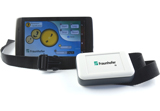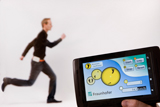More reliable and accurate localization
A new algorithm from Fraunhofer IIS detects motion reliably and accurately. It can significantly improve existing localization solutions, is easy to implement, and is independent of external infrastructure. Suppliers of localization technology can test the algorithm in a live demonstration at embedded world in Nuremberg from February 26 to 28, 2013. The demonstration will take place in Hall 4 at Booth 4-128.
Visitors to embedded world will receive a belt at the Fraunhofer booth. The belt contains sensor equipment from the Fraunhofer Institute for Integrated Circuits IIS. When the visitors move while wearing the belt, they can view their motions live on a tablet via an Android-based visualization app developed especially for trade fairs. The demo device can reliably tell whether visitors are standing, walking, or running. The system can also detect other motions, such as lying or falling.
The example of motion classification for a pedestrian presented at embedded world is only one possible application for this very flexible algorithm. Marcus Bocksch, developer at Fraunhofer IIS, explains: "Independence from external infrastructure allows the algorithm to be used on almost all existing platforms. The algorithm is suitable for such applications as protecting people's safety in road traffic and supporting existing localization solutions – for indoor localization and seamless localization, e.g. for tracking people."
Providers of localization technology can license the easy-to-implement fusion algorithm and use it for various applications.
Ideal for improving existing localization technologies
Low-cost sensors (for acceleration, rotational speed, magnetic field), such as those integrated in almost every smartphone, are used for motion classification. Other benefits include the ease of implementing the software and the fact that the motion classification works independently of any infrastructure.
The algorithm works as an assistant for localization solutions. It helps, for example, if Wi-Fi or GPS signals fail or are too weak by providing additional motion information to make positioning more reliable and accurate. For example, within buildings: Wi-Fi positioning can provide more reliable data simply by distinguishing between the states of motion and motionlessness (INDOOR project). Depending on the application, a higher level of detail regarding the state of motion may be relevant. Furthermore, the system can also determine the wearer's line of vision; in a museum, for example, visitors could be provided with targeted information about the exhibits.
Ko-TAG joint project improves traffic safety
The algorithm was devised as part of the Ko-TAG joint project. This project does research into cooperative radio-based sensor technology. This technology is being investigated with a focus on applications such as protection of vulnerable road users and vehicle-to-vehicle safety.
The aim of the overarching Ko-FAS research initiative is to make significant contributions to improving road safety, i.e. to reduce the frequency of accidents and mitigate their consequences as far as possible. It is in this context that the Ko-TAG subproject investigates cooperative sensing based on transponder systems. Ko-TAG and Ko-FAS are being funded by the German Federal Ministry of Economics and Technology (BMWI) via "Mobility and Transport Technologies" at TÜV Rheinland Consulting GmbH (funding code 19S9011E).

